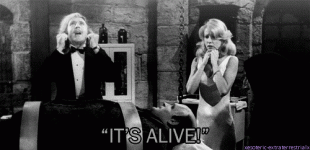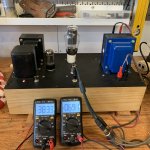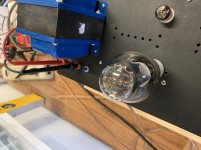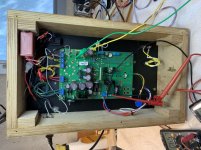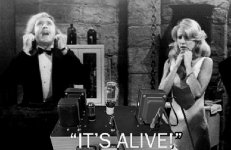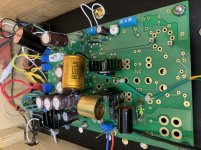Woah, those new boards look stunning, George!
Great job, hareynolds! Those big Edcor OPTs are what I chose for my SSE and the whole thing rocks.
When I was doing some net research about where the costs were and where the invariants could be - namely you could change tubes and circuits within the same type of amp but would keep the transformers - I figured I'd better get the stronger specs for the transformers for my builds, so the large CSXE are what I got as OPT.
I highly recommend them. They're big and they're also part of why I don't feel I am 'missing anything' in my amp: bass extension and bass power (for my small room though), same at the other extreme, and of course, the sweet mid-range, it's all there.
On the SSE, I just needed to hear the opening of New Order's Blue Monday to immediately hear what the SSE Triode + Edcors + my chosen Tubes do that none of my SS amps can do.
ZERO SAG.
Great job, hareynolds! Those big Edcor OPTs are what I chose for my SSE and the whole thing rocks.
When I was doing some net research about where the costs were and where the invariants could be - namely you could change tubes and circuits within the same type of amp but would keep the transformers - I figured I'd better get the stronger specs for the transformers for my builds, so the large CSXE are what I got as OPT.
I highly recommend them. They're big and they're also part of why I don't feel I am 'missing anything' in my amp: bass extension and bass power (for my small room though), same at the other extreme, and of course, the sweet mid-range, it's all there.
On the SSE, I just needed to hear the opening of New Order's Blue Monday to immediately hear what the SSE Triode + Edcors + my chosen Tubes do that none of my SS amps can do.
ZERO SAG.
+1 on the look of the new (Chinese) boards.
Pity that I would probably bury 'em in a chassis.
Maybe it's time to build a cherry or mahogany "well" with a baltic birch floor and well-perforated lexan cover...hmmmm...that would also solve the Rug-Rat Finger problem...
Pity that I would probably bury 'em in a chassis.
Maybe it's time to build a cherry or mahogany "well" with a baltic birch floor and well-perforated lexan cover...hmmmm...that would also solve the Rug-Rat Finger problem...
George, Very cool. Did you ever run the 46 in the TSE? Obviously the B+ is much lower....
When I first caught the SE fever I was buying "good used" 45's on Ebay and at hamfests for $5 to $10 each, sometimes less. When this was going on, I didn't think much about the 46's or 47's. I think I might have collected one or two of each in a "box of tubes cheap" deal, but I have never even tried to power them up. None ever met the TSE board.
Yesterday I put some Chinese 300B's in the new TSE-II board and let it play for a couple hours with the Variac turned up full. No issues were seen.
I was in the process of tearing the setup down when I found a pair of Sovtek single plate 2A3's (baby 300B's) that I didn't know I had. Of course I had to stuff them into the amp and listen for a while. They obviously had more gain then the Chinese twin plate tubes, but given the same Transcendar 3K OPT's in all testing the 300B's were the best overall sound wise.
The TSE-II board is now up on a shelf and the second UNSET proto is being connected into the same setup. In anticipation of more power output, the Transcendar's are being swapped out for Hammond 1628SEA's which can be 5K or 2.5K.
I was in the process of tearing the setup down when I found a pair of Sovtek single plate 2A3's (baby 300B's) that I didn't know I had. Of course I had to stuff them into the amp and listen for a while. They obviously had more gain then the Chinese twin plate tubes, but given the same Transcendar 3K OPT's in all testing the 300B's were the best overall sound wise.
The TSE-II board is now up on a shelf and the second UNSET proto is being connected into the same setup. In anticipation of more power output, the Transcendar's are being swapped out for Hammond 1628SEA's which can be 5K or 2.5K.
From memory, I ran them at the same B + of 275 ish, and about 23 - 25 mils.
Same for 47.
If I can find an entry in my notebook and it is different, I'll post a correction.
Thanks for the operating point info!
Yesterday I put some Chinese 300B's in the new TSE-II board and let it play for a couple hours with the Variac turned up full. No issues were seen.
I was in the process of tearing the setup down when I found a pair of Sovtek single plate 2A3's (baby 300B's) that I didn't know I had. Of course I had to stuff them into the amp and listen for a while. They obviously had more gain then the Chinese twin plate tubes, but given the same Transcendar 3K OPT's in all testing the 300B's were the best overall sound wise.
The TSE-II board is now up on a shelf and the second UNSET proto is being connected into the same setup. In anticipation of more power output, the Transcendar's are being swapped out for Hammond 1628SEA's which can be 5K or 2.5K.
George,
Based on your OPT measurements, I have been using low power Edcors and they sound fantastic. Yes, they roll off below 40hz, but for most types of music that is plenty of bandwidth. Powered subs take care of the lower octaves while relieving the amplifier of those duties.
Where these small Edcors really shine is being very low distortion on the other end of the spectrum. I really think the single digit inductance of these small transformers is why they sound so good.
This article written by Matt Renaud is excellent on why low inductance is good for overall performance.
A Consequence of The Quest for 20Hz Roll Off | Cascade Tubes
Cheers,
Greg
It’s ALIVE! TSE-II 300B Mono-Block #1
Sorry for the GIF; just wanted to take a look at Terry Garr again..
With a tiny amount of tinkering, mostly due to the MONOBLOCKnature of the beast (e.g. ~6.7 ohm resistor to get the 5842 fils down to 6.2 vdc, plus twinning the MOSFET “grid” resistor to ~36K, really 39K), everything biased-up nicely, first time. Always a SHOCK (the emotional kind) when that happens.
300B fils at 4.9something volts DC
5842 fils at 6.2something volts DC
B- span from about -35 to -183, which was nice
B+ about 350v with 5R4 in ST coke bottle for starters; switched to 5AR4 to get the numbers you see.
The EH 300B seems to like to run a little hotter, say 390 and 75 mA...so I’ll be tinkering.
PST is the ubiquitous 6K7VG, but with only 4uF Russkie OIP 1st cap; will likely raise that a bit. Obviously, it runs very cool in this application (for once..)
Choke is a Heathkit 10H, 163 DCR
OPT is the big EDCOR 25W at 5K
Right now, in the shop, have paralleled 8ohm speakers to try a 2.5K load; sounds quite good (and louder, of course) but this is a noisy, large volume space, so I couldn’t hear any degradation anyway...it does fill the 750 ft2 shop, plus some of the neighbors’ yards.
Note the external test points wired to either side of the 10 ohm 300B plate resistor., and the external 100k linear bias pot. The pot’s a single turn, and a little touchy; I’ll likely swap in a nice Bourns 10-turn like I use on regulated power supplies.
Pretty fast build, biased right up, sounds exactly like the Flexi-Amp TSE clone, except without the mild drift of the old Heathkit P/S..
Gotta tidy it up, then on to #2
Sorry for the GIF; just wanted to take a look at Terry Garr again..
With a tiny amount of tinkering, mostly due to the MONOBLOCKnature of the beast (e.g. ~6.7 ohm resistor to get the 5842 fils down to 6.2 vdc, plus twinning the MOSFET “grid” resistor to ~36K, really 39K), everything biased-up nicely, first time. Always a SHOCK (the emotional kind) when that happens.
300B fils at 4.9something volts DC
5842 fils at 6.2something volts DC
B- span from about -35 to -183, which was nice
B+ about 350v with 5R4 in ST coke bottle for starters; switched to 5AR4 to get the numbers you see.
The EH 300B seems to like to run a little hotter, say 390 and 75 mA...so I’ll be tinkering.
PST is the ubiquitous 6K7VG, but with only 4uF Russkie OIP 1st cap; will likely raise that a bit. Obviously, it runs very cool in this application (for once..)
Choke is a Heathkit 10H, 163 DCR
OPT is the big EDCOR 25W at 5K
Right now, in the shop, have paralleled 8ohm speakers to try a 2.5K load; sounds quite good (and louder, of course) but this is a noisy, large volume space, so I couldn’t hear any degradation anyway...it does fill the 750 ft2 shop, plus some of the neighbors’ yards.
Note the external test points wired to either side of the 10 ohm 300B plate resistor., and the external 100k linear bias pot. The pot’s a single turn, and a little touchy; I’ll likely swap in a nice Bourns 10-turn like I use on regulated power supplies.
Pretty fast build, biased right up, sounds exactly like the Flexi-Amp TSE clone, except without the mild drift of the old Heathkit P/S..
Gotta tidy it up, then on to #2
Attachments
Added an old French poly (polyester, not Polynesia) cap (4.7uF) across the 3.8uF Russkie PIO for a C1 of about 8.5uF, and the B+ came-up nicely to 390v at 75mA (~29W dissipation).
Pretty conservative compared to the OEM ratings:
but I think I'll leave it there for a while. This is about where I've run the TSE Clone for the last year.
Is ANYBODY running EH 300Bs over 400V and near 100mA? Just curious.
Oh, yeah: shut everything off in the shop and stood on stepladder next-to the 96dBA speakers. Dead quiet, which is nice.
Pretty conservative compared to the OEM ratings:
An externally hosted image should be here but it was not working when we last tested it.
but I think I'll leave it there for a while. This is about where I've run the TSE Clone for the last year.
Is ANYBODY running EH 300Bs over 400V and near 100mA? Just curious.
Oh, yeah: shut everything off in the shop and stood on stepladder next-to the 96dBA speakers. Dead quiet, which is nice.
Nice build! I’m never satisfied if an amp has any noise / hum heard at the speaker.
Try the Gold Lion 300...they are good!
Try the Gold Lion 300...they are good!
It’s ALIVE!

I modified the image for you so that it's more accurate to this event. 😉
Congrats! There are only small number of TSE mono owners. Maybe we can start a club.Sorry for the GIF; just wanted to take a look at Terry Garr again..

I modified the image for you so that it's more accurate to this event. 😉
Attachments
Bias DRIFT! Hot Sand!
Well, apparently I brought the bad Gri-Gri upon myself by mentioning the DRIFT of the Heathkit regulated Power Supply.
Moved the mon-block inside to the Music Salon (snort) and left a meter on the bias test points.
After about 1-1/2 to 2 hours, the underside of the chassis is hot enuf to cause the bias to drift steadily upwards.
Note: components are UNDERNEATH the board.
The Good News: sounds terrific around 100mA.
The Bad News: not likely to sound good very long if the bias keeps drifting UP & AWAY.
I DO NOT have lots of ventilation holes; will yank out the board and "install" lots more tomorrow (when doing the multi-turn bias pot).
Any suggestions on improved Thermal Management? The Index Finger Pyrometer puts most of the heat (a) over the MOSFET (b) over R36.
The existing vent holes are directly over the vent holes in the board; I'll enlarge those, plus add more, particularly around the periphery.
[Old Guy Story: Morris Garages (MG) installed a neat-looking oval vent in the "bonnet surround" of the MGA with the intention of allowing air from the radiator to escape through the cowl. Had 'UGE overheating problems in the Southern US. Somebody put it the MGA in a wind-tunnel and found that there was a high-pressure "node" EXACTLY where the designers had place the vent. Ooops.]
The ONLY anomaly in the circuit (other that the small C1 in the power supply) is that the MOSFET "grid" resistor (R25) is ~39K instead of the recommended 36K (for B+ 350-400V); I didn't have a 36K 3 watt, so have 2 x 20K 3W in series, measured at 39K.
Don't know exactly WHAT is getting too warm and allowing the bias to creep-up slowly.
(a) regardless, with so much hot "sand" under there, we need more ventilation.
(b) if R-25 (MOSFET voltage-setting "grid" resistor) gets too hot and "drops" resistance, would THAT increase bias current?
(c) similarly, could it be the MOSFET itself? Perhaps a supplemental heat sink?
Suggestions gratefully accepted.
Man, she sounds tee-rific, but she's very hot-headed.
Well, apparently I brought the bad Gri-Gri upon myself by mentioning the DRIFT of the Heathkit regulated Power Supply.
Moved the mon-block inside to the Music Salon (snort) and left a meter on the bias test points.
After about 1-1/2 to 2 hours, the underside of the chassis is hot enuf to cause the bias to drift steadily upwards.
Note: components are UNDERNEATH the board.
The Good News: sounds terrific around 100mA.
The Bad News: not likely to sound good very long if the bias keeps drifting UP & AWAY.
I DO NOT have lots of ventilation holes; will yank out the board and "install" lots more tomorrow (when doing the multi-turn bias pot).
Any suggestions on improved Thermal Management? The Index Finger Pyrometer puts most of the heat (a) over the MOSFET (b) over R36.
The existing vent holes are directly over the vent holes in the board; I'll enlarge those, plus add more, particularly around the periphery.
[Old Guy Story: Morris Garages (MG) installed a neat-looking oval vent in the "bonnet surround" of the MGA with the intention of allowing air from the radiator to escape through the cowl. Had 'UGE overheating problems in the Southern US. Somebody put it the MGA in a wind-tunnel and found that there was a high-pressure "node" EXACTLY where the designers had place the vent. Ooops.]
The ONLY anomaly in the circuit (other that the small C1 in the power supply) is that the MOSFET "grid" resistor (R25) is ~39K instead of the recommended 36K (for B+ 350-400V); I didn't have a 36K 3 watt, so have 2 x 20K 3W in series, measured at 39K.
Don't know exactly WHAT is getting too warm and allowing the bias to creep-up slowly.
(a) regardless, with so much hot "sand" under there, we need more ventilation.
(b) if R-25 (MOSFET voltage-setting "grid" resistor) gets too hot and "drops" resistance, would THAT increase bias current?
(c) similarly, could it be the MOSFET itself? Perhaps a supplemental heat sink?
Suggestions gratefully accepted.
Man, she sounds tee-rific, but she's very hot-headed.
BIAS DRIFT Repair Plan
Today, I'll pullout the board, and
(a) drill more/larger vent holes
(b) check/redo the heat-sink attachments (possibly add thermal "grease")
(c) change the MOSFET "grid" (voltage-setting) resistor (R25) back to 36K
(d) change bias pot to 100K linear 10-turn Bourns
While I've got the board out, is there anything else I should be doing
(1) larger heat sink for MOSFET?
(2) REPLACE the MOSFET?
(3) Higher wattage resistors?
Any suggestions welcome...
Today, I'll pullout the board, and
(a) drill more/larger vent holes
(b) check/redo the heat-sink attachments (possibly add thermal "grease")
(c) change the MOSFET "grid" (voltage-setting) resistor (R25) back to 36K
(d) change bias pot to 100K linear 10-turn Bourns
While I've got the board out, is there anything else I should be doing
(1) larger heat sink for MOSFET?
(2) REPLACE the MOSFET?
(3) Higher wattage resistors?
Any suggestions welcome...
Before you go crazy with holes, larger heat sinks might solve all of it. When that doesn’t work, I resort to my weapon of choice: a large heat spreader, i.e., the top deck. I mount all of my devices if possible to the top deck and use it as a heat sink, which in your case will require some rework. You could just do them on short flying leads.
I’ve also just mounted large copper sheets to the inside of my boxes (if made from wood) and mounted devices to the sheet.
I’ve also just mounted large copper sheets to the inside of my boxes (if made from wood) and mounted devices to the sheet.
Wandering bias, continued...
Back together after a brief trip to the chiropractor ( the TSE, not me).
R25 is now just under 36K.
Bourns 10-turn bias pot installed. I love these things..
Replaced the MOSFET OUT OF AN ABUNDANCY OF CAUTION, plus added a “supplemental” heat sink made from a curlicue strip of brass shim-stock.
Though I had another tall Heatsink, but they were wrong pin-out..
Using my 20-year old faithful (and well-abused) EH Gold 300B, the bias upward drift is still there, but APPEARS to have showed considerably. Looks like we may be close to reaching a Steady-State after about 45 minutes.
The Bourns 10-T pot is adjustable to THOUSANDTHS of a voltage (across the 10 ohm plate resistor) which a pleasant (if inherently false) thing.
Adjusting bias to 65 mA; plate stays pretty constant around 392 vdc.
IF it does actually stabilize, then it will be interesting how long it takes to warm-up to Steady State on start-up (and what the initial bias will be).
Clapton Unplugged “Walking Blues” playing now, loud, and as good as I’ve heard it. I can hear the slide across the bass strings. Yikes.
The 300B TSE definitely seems worth the pound of flesh it has cost so far...
Back together after a brief trip to the chiropractor ( the TSE, not me).
R25 is now just under 36K.
Bourns 10-turn bias pot installed. I love these things..
Replaced the MOSFET OUT OF AN ABUNDANCY OF CAUTION, plus added a “supplemental” heat sink made from a curlicue strip of brass shim-stock.
Though I had another tall Heatsink, but they were wrong pin-out..
Using my 20-year old faithful (and well-abused) EH Gold 300B, the bias upward drift is still there, but APPEARS to have showed considerably. Looks like we may be close to reaching a Steady-State after about 45 minutes.
The Bourns 10-T pot is adjustable to THOUSANDTHS of a voltage (across the 10 ohm plate resistor) which a pleasant (if inherently false) thing.
Adjusting bias to 65 mA; plate stays pretty constant around 392 vdc.
IF it does actually stabilize, then it will be interesting how long it takes to warm-up to Steady State on start-up (and what the initial bias will be).
Clapton Unplugged “Walking Blues” playing now, loud, and as good as I’ve heard it. I can hear the slide across the bass strings. Yikes.
The 300B TSE definitely seems worth the pound of flesh it has cost so far...
Attachments
We definitely got an asymptotic-looking function going-on over here.
Gettin’ close to steady-state at just over an hour....
PS measuring bias with the inputs turned-off but not disconnected...
Gettin’ close to steady-state at just over an hour....
PS measuring bias with the inputs turned-off but not disconnected...
The minute I started playing Cool Jazz (Jazz @ The Pawnshop) the bias cooled-down a couple of milliamperes, and is just sitting there (snapping fingers, I assume).
Coincidence? I Think Not.
Looks like it has +/- reached a steady state at ~65 mA and ~390Vp, give or take...
Next step, honking big (tall) Heatsink that will fit the board.
Since I’m only using ONE CHANNEL, I wonder if I could “thermally tie” to an unused Heatsink for the other channel...hung...
Coincidence? I Think Not.
Looks like it has +/- reached a steady state at ~65 mA and ~390Vp, give or take...
Next step, honking big (tall) Heatsink that will fit the board.
Since I’m only using ONE CHANNEL, I wonder if I could “thermally tie” to an unused Heatsink for the other channel...hung...
good morning from Greece.. i am in search of a nice 300b se pcb with good documentation since although i am good at soldering, i am terrible in electronics theory.. so Tubelab 300b drawed my attention... How can i order the board?..since in Greece the "iron" options are a bit limited, i want to check the total costs before proceeding.. also is there any "guide" for the TSE-II as the one for the tubelab-se that already exists? thanks in advance
All the Yanks with normal Circadian Rythms are SLEEPING, but here’s what I’ve found:
The documentation for the TSE-II is a combination of the TSE pages on the TubeLab website AND information on DIYaudio, primarily THIS thread.
This “documentation” is NOT as detailed or comprehensive as the TubeLab SSE on the website (with added community support on DIYaudio), but it’s probably better and more organized than what’s available for the designs by your countryman SALAS; don’t get me wrong, I like the Salas designs, but he relies nearly entirely on the DIYaudio forum, which requires reading GIGANTIC threads, plus taking NOTES like you’re still at school. To his credit, Salas seems to LIVE on the forum and sleep even less than me, so answers are rarely more than 24 hours away.
If you’re very well experienced tube builder, I think the TSE-II is the very best sounding amp I have built. HOWEVER, it is not without it’s pitfalls and surprises.
Right now I am struggling with wandering bias which APPEARS to be caused by HOT MOSFETS. I think I’m about halfway to a solution, but it has taken DAYS of tinkering with no “support”. No worries for me (a crusty old pensioner), but the TSE was never intended as a plug & play project.
If you are less experienced, I think that the TubeLab SSE is probably the best beginner/intermediate amp board available. Folks, including myself, have done some wild stuff with the SSE boards, up to a DHT Amp with off-board 4-pin sockets (see W5JAG posts). I myself have done some wacky experimentation with sweep tubes using the SSE board on a permanent breadboard that’s 10 years old. My shop amp is an SSE w/KT88s, and I’m building a “deluxe” version for our vacation cottage, likely with KT66s.
The documentation for the TSE-II is a combination of the TSE pages on the TubeLab website AND information on DIYaudio, primarily THIS thread.
This “documentation” is NOT as detailed or comprehensive as the TubeLab SSE on the website (with added community support on DIYaudio), but it’s probably better and more organized than what’s available for the designs by your countryman SALAS; don’t get me wrong, I like the Salas designs, but he relies nearly entirely on the DIYaudio forum, which requires reading GIGANTIC threads, plus taking NOTES like you’re still at school. To his credit, Salas seems to LIVE on the forum and sleep even less than me, so answers are rarely more than 24 hours away.
If you’re very well experienced tube builder, I think the TSE-II is the very best sounding amp I have built. HOWEVER, it is not without it’s pitfalls and surprises.
Right now I am struggling with wandering bias which APPEARS to be caused by HOT MOSFETS. I think I’m about halfway to a solution, but it has taken DAYS of tinkering with no “support”. No worries for me (a crusty old pensioner), but the TSE was never intended as a plug & play project.
If you are less experienced, I think that the TubeLab SSE is probably the best beginner/intermediate amp board available. Folks, including myself, have done some wild stuff with the SSE boards, up to a DHT Amp with off-board 4-pin sockets (see W5JAG posts). I myself have done some wacky experimentation with sweep tubes using the SSE board on a permanent breadboard that’s 10 years old. My shop amp is an SSE w/KT88s, and I’m building a “deluxe” version for our vacation cottage, likely with KT66s.
- Home
- More Vendors...
- Tubelab
- After a 14 year run, the TSE must DIE!
